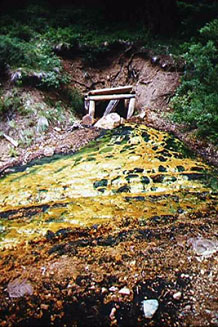Note: For the most up to date information on the Sierra Club’s efforts to stop sulfide mining, please see our Stop Sulfide Mining page, and blog.
 Since the founding of the North Star Chapter in 1968, Sierra Club volunteers have been actively involved in mining issues within Minnesota: protecting Duluth’s drinking water from asbestos-like fibers in the Reserve Mining case; copper-nickel mining, the expansion of taconite plants and processing facilities, and more recently frac sand mining. A resurgence of high metal prices worldwide has triggered interest from multinational mining companies looking to take advantage of the state’s mineral resources.
Since the founding of the North Star Chapter in 1968, Sierra Club volunteers have been actively involved in mining issues within Minnesota: protecting Duluth’s drinking water from asbestos-like fibers in the Reserve Mining case; copper-nickel mining, the expansion of taconite plants and processing facilities, and more recently frac sand mining. A resurgence of high metal prices worldwide has triggered interest from multinational mining companies looking to take advantage of the state’s mineral resources.
While Minnesota is just beginning to acknowledge the impacts of legacy mining in the state, a much more dangerous threat looms – sulfide mining. Vast deposits of low-grade disseminated (scattered throughout the rock in low concentrations) copper, nickel, and associated trace metals lie within the northeast corner of Minnesota and have sparked a frenzy of exploration from international corporations looking to cash in on the state’s resources.
Metallic sulfide mining is a type of mining never before permitted in the land of 10,000 lakes. The mining of copper/nickel sulfide ores is a toxic type of mining that is risky to our environment, our workers and communities, and local economies. Mining sulfide rock releases acid and toxic metals and contaminants that pollute rivers and groundwater for hundreds of years, long after the profits are spent and the products buried in landfills.
Sulfide ores contain metals (such as copper or nickel) that are bonded to sulfur, forming sulfide minerals. When exposed to air and moisture, a chemical reaction occurs that generates sulfuric acid that migrates into the surrounding environment and, through leaching, releases heavy metals present in the waste rock, pit walls, and tailings basins of mining operations into streams and lakes at levels that are toxic to fish and other aquatic life. This form of pollution is commonly referred to as Acid Mine Drainage (AMD) and has the potential to devastate entire ecosystems. The close proximity of these mines to valued water bodies such as the Boundary Waters Canoe Area Wilderness and Lake Superior only intensifies the magnitude of this issue.
To make matters worse, the sulfide mining industry has a poor history of stewardship, integrity and accountability. To date, no sulfide mine has been able to operate without causing some form of pollution in the surrounding environment. Many companies point to the Flambeau Mine as a model case of environmental restoration; however, a 2012 federal ruling noted multiple violations of the Clean Water Act at the Flambeau site. Neighboring states such as Wisconsin have already issued a moratorium requiring sulfide mining companies to prove that sulfide mining has successfully been done elsewhere, without causing water pollution, before the allowance of mines there. Unfortunately, Minnesota state legislators seem to be ignoring environmental safeguards in order to advance the interests of multi-national corporations. Despite this, solutions such as requiring proof that mining has been done without harm in a similar climate; protecting pristine natural areas from disturbance; not mining where perpetual treatment of mine drainage pollution is required; and demanding secure and significant financial assurance for both perpetual and unintended consequences from mining, can help keep our waters clean for future generations.
Where the Sierra Club stands: Let’s ask for proof, not promises from promoters of metallic sulfide mining in Minnesota’s precious north woods.